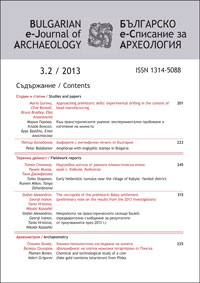Амфорите с енглифични печати от България
Amphorae with englyphic stamps in Bulgaria
Author(s): Petar BalabanovSubject(s): Archaeology
Published by: Асоциация на българските археолози
Keywords: Amphorae; englyphic stamps; Apollonia Pontica; Heraclea Pontica; Ancient Thrace
Summary/Abstract: The publications of new materials allow to make observations on the characteristics, origin, dating and spatial distribution of the amphorae with englyphic stamps in Bulgaria. Obviously the discussion about the origin of these amphorae will continue until incontestable evidence is found, such as furnaces or remains of their manufacture in situ or until a highly representative chemical analyses of the clay is carried out. The amphorae with englyphic stamps differ from most of the similar vessels manufactured during the Classical and the Hellenistic periods in several typical particularities The oldest stamps bearing only one name, were determined to belong the last years of the 5th c. BC and the first decade of the 4th c. BC. The dating of the stamps bearing eponymous name often with the affix “επι” at the beginning is more complicated. As a whole they are included in the period from 390/385 to 325/315 BC. The dating of the latest specimens of this type of vessels remains under discussion. Against the backdrop of the current studies related to the importation of Greek amphorae in Ancient Thrace, the large spread of vessels marked with englyphic stamps in a vast geographical region (Dobrudzha and Ludogorie, to the west of the river Yantra and across the Thracian plain and the sub-Balkan valleys up to the nominal line to the west between Simeonovgrad-Elkhovo-Fakia) represents an interesting phenomenon.
Journal: Българско е-Списание за Археология
- Issue Year: 3/2013
- Issue No: 2
- Page Range: 223-243
- Page Count: 20
- Language: Bulgarian

